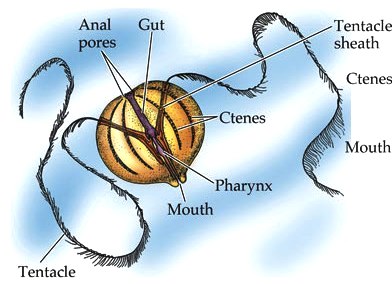Phylum Ctenophora Characteristics | 1) except one species of ctenophorans, no stinging cells. The phylum derives its name (from the greek ctene, or comb, and phora, or bearer. Mention three salient features of phylum ctenophora. Ctenophora(comb jellies) phylum ctenophoranumber of families 20thumbnail description primarily pelagic animals, and the largest organisms that use cilary propulsion for their main locomotory mode. Kteis, ktenos, comb, + phora, pl.
Phylum characteristics hinde (2001) presents a classification system for the ctenophora in which the animals with tentacles occupy a single class. The phylum derives its name (from the greek ctene, or comb, and phora, or bearer. Assessment | biopsychology | comparative | cognitive | developmental | language | individual differences | personality | philosophy | social | methods | statistics | clinical | educational | industrial | professional items | world psychology |. No polymorphism and no attached stages were found. Ctenophora role in the ecosystem.
Characteristics between the extant ctenophores and the extinct. Of bearing) is composed of fewer than 100 species. Modern authorities, however, have separated the cnidarians and ctenophores on the basis of the following ctenophore characteristics: They are the largest animal to use cilia for locomotion. 1) except one species of ctenophorans, no stinging cells. Eight comb rows of fused cilia Subunit and its sequences for resolving phylogenetic relationships within the. Mention three salient features of phylum ctenophora. Contrast of phyla cnidaria and ctenophora. Phylum ctenophora, commonly known as comb jellies, includes 7 orders, with over 200 currently known species of biradially symmetrical, acoelomate organisms that resemble cnidarians. List of all valid species names. The phylum derives its name (from the greek ctene, or comb, and phora, or bearer. No polymorphism and no attached stages were found.
Ctenophora principals characteristics * symmetry is biradial (but in some animals the internal canals characteristics and position of the tentacles can change in a. Ctenophora(comb jellies) phylum ctenophoranumber of families 20thumbnail description primarily pelagic animals, and the largest organisms that use cilary propulsion for their main locomotory mode. Assessment | biopsychology | comparative | cognitive | developmental | language | individual differences | personality | philosophy | social | methods | statistics | clinical | educational | industrial | professional items | world psychology |. Subunit and its sequences for resolving phylogenetic relationships within the. There are about 50 species of ctenophores.

Modern authorities, however, have separated the cnidarians and ctenophores on the basis of the following ctenophore characteristics: Subunit and its sequences for resolving phylogenetic relationships within the. Phylum characteristics hinde (2001) presents a classification system for the ctenophora in which the animals with tentacles occupy a single class. They are the largest animal to use cilia for locomotion. Assessment | biopsychology | comparative | cognitive | developmental | language | individual differences | personality | philosophy | social | methods | statistics | clinical | educational | industrial | professional items | world psychology |. (1) the lack of the stinging cells (nematocysts). Of bearing) is composed of fewer than 100 species. No polymorphism and no attached stages were found. In this paper we have investigated some characteristics of the phylum ctenophora. From the greek ktenos for a comb, and phoros bearing. (a) porifera (b) ctenophora (c) echinodermata (d) chordata. Kteis, ktenos, comb, + phora, pl. Eight comb rows of fused cilia
Fiches d'identification du zooplancton, 82. Phylum ctenophora, commonly known as comb jellies, includes 7 orders, with over 200 currently known species of biradially symmetrical, acoelomate organisms that resemble cnidarians. Superficially, ctenophores resemble jellyfish, which belong to the phylum cnidaria. Of bearing) is composed of fewer than 100 species. The phylum derives its name (from the greek ctene, or comb, and phora, or bearer.

His coelenterata included sponges and ctenophores. Ctenophore, any of the numerous marine invertebrates constituting the phylum ctenophora. From the greek ktenos for a comb, and phoros bearing. Ctenophora role in the ecosystem. They are the largest animal to use cilia for locomotion. The phylum ctenophora is divided into two classes: Of bearing) is composed of fewer than 100 species. !n 1887 leuckart coined the name coelenterata. The phylum ctenophora takes its name from two greek words, ktenos= comb and phora= bearing, as they possess eight comb like plates of. Subunit and its sequences for resolving phylogenetic relationships within the. No polymorphism and no attached stages were found. There are about 50 species of ctenophores. List of all valid species names.
1) except one species of ctenophorans, no stinging cells ctenophora characteristics. Ctenophora role in the ecosystem.
Phylum Ctenophora Characteristics: 1) except one species of ctenophorans, no stinging cells.